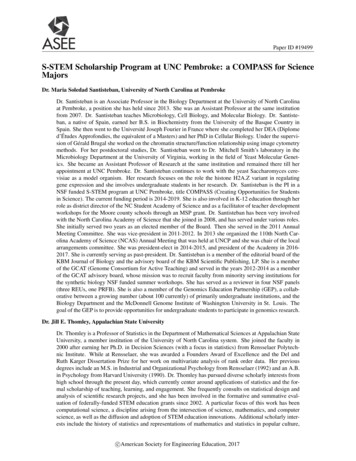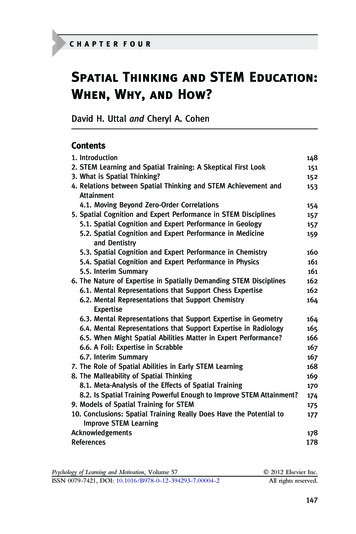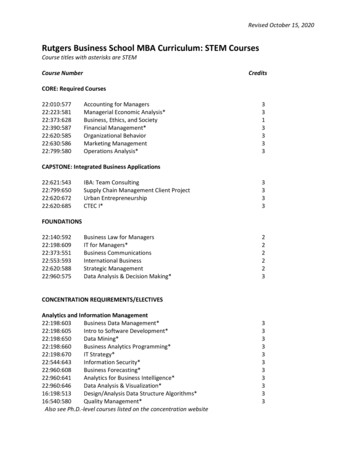
Transcription
STEM 101: Intro to tomorrow’s jobs2 Occupational Outlook Quarterly Spring 2014 www.bls.gov/ooq
“The future of the economy is inSTEM,” says James Brown, theexecutive director of the STEMEducation Coalition in Washington, D.C.“That’s where the jobs of tomorrow will be.”Data from the U.S. Bureau of LaborStatistics (BLS) support that assertion.Employment in occupations related toSTEM—science, technology, engineering, andmathematics—is projected to grow to morethan 9 million between 2012 and 2022. That’san increase of about 1 million jobs over 2012employment levels.Dennis VilorioDennis Vilorio isan economist inthe Office of Occupational Statistics and Employment Projections,BLS. He can bereached at (202)691-5711 or atvilorio.dennis@bls.gov.STEM fields are closely related and buildon each other. For example, math providesthe foundation for physics—and physics, inturn, for engineering. Engineers can applytheir knowledge of physics to make high-techdevices that are useful for testing theories inphysics. Advances in physics may then lead toadvances in engineering and technology.To better understand STEM, a briefdescription of each field follows.ScienceThis article provides an overview ofSTEM work, analyzing nearly 100 occupations from a list created by a committeecomprising several federal agencies. The firstsection of the article offers a brief descriptionof the life and physical sciences, computerscience, engineering, and mathematics fields.The second section includes data showingselected STEM occupations with the mostemployment and projected job openingsand growth. The third section discusses therewards and challenges of STEM work. Thefourth section describes how to prepare for acareer in a STEM field. Resources for moreinformation are listed at the end of the article.Science workers study the physical andnatural world through observation and experimentation. “Science is a lens to interpret theworld,” says Julie Herrick, a volcanologist atthe Smithsonian Institution National Museumof Natural History in Washington, DC. “Myjob is to expand knowledge.” Science workers can also inform public policy, such as byproviding data to support limits on the use oftoxic chemicals.What is STEM?Workers rely on the scientific method toobjectively test hypotheses and theories. Thescientific method requires repeatable experiments that produce predictable and observabledata. When the data matches a theory’s predictions, the experiment supports that theory.Theories with the most supportive evidenceare adopted but may continue to evolve, basedon new evidence.There is no universally agreed-upon definitionof STEM. Experts generally do agree, however, that STEM workers use their knowledgeof science, technology, engineering, or mathto try to understand how the world works andto solve problems. Their work often involvesthe use of computers and other tools.STEM occupations are identified in avariety of ways. This article uses a list basedon the Standard Occupational Classification Manual to analyze occupations from sixgroups, including computer and mathematics;architecture and engineering; and life, physical, and social sciences. (See table 1 on page4.) Healthcare occupations are excluded fromthis analysis, because they are described in aseparate article in this issue of the Quarterly.3 Occupational Outlook Quarterly Spring 2014 www.bls.gov/ooqThe work of scientists often involvesresearch, writing proposals and academicpapers, and presenting findings. Science technicians collect samples, conduct experiments,and do other tasks to assist scientists in thoseefforts.Disciplines in science are categorizedbased on the part of the universe they study:space sciences, earth sciences, life sciences,chemistry, and physics. For example, the lifesciences study the living world, such as plantsor the human body; disciplines include ecology, genetics, neuroscience, pathology, andnutrition.(Continued on page 5)
Table 1: STEM occupations, by occupational groupManagementArchitectural and engineering managersComputer and information systemsmanagersElectrical and electronics engineeringtechniciansElectrical engineersElectro-mechanical techniciansForensic science techniciansForest and conservation techniciansForestersGeological and petroleum techniciansNatural sciences managersElectronics engineers, except computerComputer and mathematicsEnvironmental engineering techniciansGeoscientists, except hydrologists andgeographersActuariesEnvironmental engineersHydrologistsComputer and informationresearch scientistsHealth and safety engineers, exceptmining safety engineers and inspectorsLife, physical, and social sciencetechnicians, all otherComputer network architectsIndustrial engineering techniciansMaterials scientistsComputer network support specialistsIndustrial engineersMedical scientists, except epidemiologistsComputer programmersMarine engineers and naval architectsMicrobiologistsComputer systems analystsMaterials engineersNuclear techniciansComputer user support specialistsMechanical draftersPhysicistsDatabase administratorsMechanical engineering techniciansSoil and plant scientistsInformation security analystsMechanical engineersZoologists and wildlife biologistsMathematical techniciansMining and geological engineers,including mining safety engineersBiological scientists, all otherMathematiciansNetwork and computer systemsadministratorsNuclear engineersPetroleum engineersOperations research analystsSurveying and mapping techniciansSoftware developers, applicationsDrafters, all otherSoftware developers, systems softwareEngineering technicians, except drafters,all otherLife scientists, all otherPhysical scientists, all otherEducation, training, and libraryAgricultural sciences teachers,postsecondaryArchitecture teachers, postsecondaryEngineers, all otherAtmospheric, earth, marine, and spacesciences teachers, postsecondaryLife, physical, and social sciencesBiological science teachers, postsecondaryAgricultural and food science techniciansChemistry teachers, postsecondaryAnimal scientistsComputer science teachers, postsecondaryArchitecture and engineeringAstronomersEngineering teachers, postsecondaryAerospace engineering and operationstechniciansAtmospheric and space scientistsEnvironmental science teachers,postsecondaryStatisticiansWeb developersComputer occupations, all otherMathematical science occupations,all otherAerospace engineersAgricultural engineersArchitectural and civil draftersBiomedical engineersChemical engineersCivil engineering techniciansCivil engineersComputer hardware engineersElectrical and electronics draftersBiochemists and biophysicistsBiological techniciansChemical techniciansForestry and conservation scienceteachers, postsecondaryChemistsMathematical science teachers,postsecondaryConservation scientistsPhysics teachers, postsecondaryEnvironmental science and protectiontechnicians, including healthSales and relatedEnvironmental scientists and specialists,including healthEpidemiologistsSales engineersSales representatives, wholesale andmanufacturing, technical and scientificproductsFood scientists and technologistsSource: 2010 Standard Occupational Classification (SOC) System, SOC Policy Committee recommendation to the Office of Management and Budget.Healthcare occupations are not included.4 Occupational Outlook Quarterly Spring 2014 www.bls.gov/ooq
(Continued from page 3)TechnologyTechnology workers use science and engineering to create and troubleshoot computer andinformation systems. For example, some techworkers develop software applications andbuild and maintain computer networks anddatabases.Technology work connects people, making all forms of communication—includingbusiness transactions, video sharing, andmobile browsing—faster and less expensive.The work often involves designing, testing,maintaining, and improving computer software, hardware, systems, and networks. “Thegoal is not only to solve a problem, but alsoto make that problem easier to solve in thefuture,” says Dan Parsons, an IT manager inPortland, Oregon.STEM technology refers to disciplines incomputer and information sciences, includingthose related to operating systems, artificialintelligence, programming, cryptography, andmobile computing.EngineeringEngineers and engineering techniciansuse math, science, and technology to solveSTEM fields oftenbuild on each other.New knowledge leadsto innovations, andvice versa.real-world problems. The work often involvesdeveloping systems, structures, products,or materials. For example, a civil engineermight design a new train station to accommodate more passengers, and an environmentalengineering technician might help create anenvironmental remediation device.“Engineering makes things better andcheaper for everyone,” says Patrick Holm, aproject civil engineer in Olympia, Washington. “Without it, we couldn’t live in the kindof society we know—with bridges, cleanwater, and cars.”Disciplines in engineering are often categorized by industry, such as aerospace, petroleum, or textiles. Major disciplines includecivil, mechanical, industrial, electrical, andmaterials engineering.MathematicsMath workers use numerical, spatial, and logical relationships to study and solve problems.For example, an operations research analysthelps organizations identify practices thatimprove efficiency, and a mathematical technician applies standard formulas to technological problems in engineering and physicalsciences.Mathematics is the technical foundationfor science, engineering, and technology. Thework often involves finding patterns in dataor abstract logic. These patterns can be usedto draw general conclusions about data, to testmathematical relationships, and to model thereal world.Disciplines in math include algebra, statistics, calculus, game theory, and geometry.Outlook and wagesOverall, STEM occupations are projected togrow faster than the average for all occupations. And wages in these occupations weregenerally higher than the median for all occupations in May 2013.This section explores the outlook andwages of STEM, both in general and forselected occupations.5 Occupational Outlook Quarterly Spring 2014 www.bls.gov/ooq
OutlookBLS projects overall STEM employment,as defined in this article, to grow about 13percent between 2012 and 2022. This is fasterthan the 11-percent rate of growth projectedfor all occupations over the decade.Most job openings. An occupation’sprojected job openings result from two factors: the creation of new jobs and the needto replace workers who retire or otherwisepermanently leave. Occupations with morejob openings usually offer more employmentopportunities.But projected employment growth variesby occupation. Knowing which occupationsare projected to have the most job openingsand fastest growth may help you narrow yourcareer options.As table 2 shows, many of these STEMoccupations are related to technology. Forexample, BLS projects applications softwaredevelopers to have more than 200,000 jobopenings between 2012 and 2022.Table 2: Selected STEM occupations with many job openings, projected 2012–22Job openings,projected 2012–22OccupationEmployment2012Projected 2022Median annualwage, May 2013Typical entry-leveleducation1Software developers, applications218,500613,000752,900 92,660Bachelor’s degreeComputer systems analysts209,600520,600648,40081,190Bachelor’s degreeComputer user supportspecialists2196,900547,700658,50046,620Some college,no degreeSoftware developers,systems software134,700405,000487,800101,410Bachelor’s degreeCivil engineers120,100272,900326,60080,770Bachelor’s degreeComputer programmers118,100343,700372,10076,140Bachelor’s degreeSales representatives, wholesaleand manufacturing, technicaland scientific products2111,800382,300419,50074,520Bachelor’s degreeNetwork and computer chelor’s degreeMechanical engineers99,700258,100269,70082,100Bachelor’s degreeComputer and informationsystems managers397,100332,700383,600123,950Bachelor’s degreeIndustrial engineers75,400223,300233,40080,300Bachelor’s degreeArchitectural and helor’s degreeWeb developers50,700141,400169,90063,160Associate’s degree44,100166,100174,00089,180Bachelor’s degree43,500143,400164,30095,380Bachelor’s degreeElectrical engineers3Computer network architectsUnless otherwise specified, occupations typically require neither work experience in a related occupation nor on-the-job trainingto obtain competency.2In addition to the education specified, this occupation typically requires moderate-term on-the-job training for workersto obtain competency.3In addition to the education specified, this occupation typically requires 5 years or more of work experience in a related occupation.Source: U.S. Bureau of Labor Statistics, Employment Projections program (employment, projections, and education data) andOccupational Employment Statistics survey (wage data).16 Occupational Outlook Quarterly Spring 2014 www.bls.gov/ooq
Fastest growing. Nearly all STEM occupations discussed in this article are projectedto grow between 2012 and 2022, accordingto BLS. And many STEM occupations areprojected to grow faster than the average forall occupations. Some of these occupations arein technology; others are related to math andengineering. (See table 3.)Between 2012 and 2022, BLS projects thefastest growing occupations to have many jobopenings relative to their employment size.But that doesn’t necessarily mean that theseoccupations have high employment. Someoccupations, such as biomedical engineers andmathematicians, have small employment levels and are projected to remain small, despitefast growth.Occupations with both high employmentand fast growth usually offer better opportunities than small occupations with slow growth.High-employment, fast-growth occupationsinclude computer systems analysts, applications software developers, and systems software developers.WagesBLS data show that workers in the STEMoccupations discussed in this article earned aTable 3: Selected STEM occupations with fast employment growth, projected 2012–22OccupationEmploymentgrowth, projected2012–22 (percent)Employment2012Median annualwage,May 2013Projected 2022Typical entry-leveleducation1Information security analysts237%75,100102,500 88,590Bachelor’s degreeOperations research analysts2773,20092,70074,630Bachelor’s degreeStatisticians2727,60034,90079,290Master’s degreeBiomedical engineers2719,40024,60088,670Bachelor’s degreeActuaries32624,30030,60094,340Bachelor’s degreePetroleum engineers2638,50048,400132,320Bachelor’s degreeComputer systems analysts25520,600648,40081,190Bachelor’s degreeSoftware developers, applications23613,000752,90092,660Bachelor’s degreeMathematicians233,5004,300102,440Master’s degreeSoftware developers, systems software20405,000487,800101,410Bachelor’s degreeComputer user support specialists420547,700658,50046,620Some college,no degreeWeb developers20141,400169,90063,160Associate’s degreeCivil engineers20272,900326,60080,770Bachelor’s degreeBiological science teachers,postsecondary2061,40073,40075,740Doctoral orprofessional degreeEnvironmental science and protectiontechnicians, including health1932,80038,90041,700Associate’s degreeUnless otherwise specified, occupations typically require neither work experience in a related occupation nor on-the-job trainingto obtain competency.2In addition to the education specified, this occupation typically requires less than 5 years of work experience in a related occupation.3In addition to the education specified, this occupation typically requires long-term on-the-job training for workersto obtain competency.4In addition to the education specified, this occupation typically requires moderate-term on-the-job training for workersto obtain competency.Source: U.S. Bureau of Labor Statistics, Employment Projections program (employment, projections, and education data) andOccupational Employment Statistics survey (wage data).17 Occupational Outlook Quarterly Spring 2014 www.bls.gov/ooq
median annual wage of nearly 76,000—morethan double the 35,080 median wage for allworkers in May 2013. Many of the top-payingoccupations are related to engineering. (Seetable 4.)Rewards and challengesSTEM work, like that of most jobs, is bothrewarding and challenging. You might workon an interesting project that yields meaningful results, for example—but, to complete it,you might need to repeat an experiment manytimes or navigate complex government regulations.RewardsMany STEM workers find their jobs intellectually stimulating. They enjoy collaborating with people who share their enthusiasmand working with cutting-edge technology.“STEM offers a cooperative, innovative, andexciting work environment that is unparalleled,” says Aimee Kennedy, vice presidentfor education and STEM learning at BattelleMemorial Institute in Columbus, Ohio.Depending on the occupation, STEMwork may be creative and produce tangibleresults. For example, a biologist might makea discovery in the laboratory and publish thatTable 4: Median annual wages in selected STEM occupations, May 2013EmploymentMedian annualwage, May 20132012 132,32038,50048,400Bachelor's degreeArchitectural and engineering managers2128,170193,800206,900Bachelor's degreeComputer and information systems managers2123,950332,700383,600Bachelor's degreeNatural sciences managers2116,84051,60054,500Bachelor's degreeAstronomers110,4502,7002,900Doctoral orprofessional degreePhysicists110,11020,60022,700Doctoral orprofessional degreeComputer and informationresearch scientists106,29026,70030,800Doctoral orprofessional degreeComputer hardware engineers104,25083,30089,400Bachelor's degreeAerospace engineers103,87083,00089,100Bachelor's degreeMathematicians102,4403,5004,300Nuclear engineers101,60020,40022,300Bachelor's degreeSoftware developers, systems software101,410405,000487,800Bachelor's degree95,73033,30034,800Bachelor's degreeComputer network architects95,380143,400164,300Bachelor's degreeEngineering teachers, postsecondary94,46042,50047,500OccupationPetroleum engineersChemical engineers2Projected 2022Typical entry-leveleducation1Master's degreeDoctoral orprofessional degreeUnless otherwise specified, occupations typically require neither work experience in a related occupation noron-the-job training to obtain competency.2In addition to the education specified, this occupation typically requires 5 years or more of work experience in arelated occupation.Source: U.S. Bureau of Labor Statistics, Employment Projections program (employment, projections, and education data)and Occupational Employment Statistics survey (wage data).18 Occupational Outlook Quarterly Spring 2014 www.bls.gov/ooq
mathematical statistician at BLS in Washington, DC.Other challenges vary, depending on thefield. For example, many jobs in scientificresearch receive short-term financial support,so these workers often worry about funding.And engineering workers must juggle different priorities, from clients and the government, while keeping a project on schedule.“There are a lot of demands to satisfy,” Holmsays, “so you can’t always do what you thinkis the best solution.”Despite the challenges, however, STEMworkers often report feeling respected andfulfilled. “You feel that what you’re doing isimportant and you matter as an employee,”says Tirado. “People value your skills, listento your ideas, and think that what you do ismagic.”STEM work may producetangible results, such asa skyscraper designed tocertain specifications.Getting startedresearch in a scientific journal. A civil engineering technician may help design a storagefacility or other structure and then assist inworking with the contractor who builds it.Workers in STEM occupations also enjoythe variety of problems they solve. “Everyproblem is a unique challenge to figure out,”Holm says. “Even if you use similar skills, theway you apply them is different.”Because many STEM fields involve rapidchange, workers’ professional developmentis also dynamic. “There’s always somethingmore to learn,” says Herrick. “Don’t expect anend.”ChallengesAs rewarding as STEM work may be, itcan sometimes be demanding and tedious.For example, projects may take hundredsof hours over weeks or months to complete.And routine tasks may include catalogingdata, filling out paperwork, and documenting observations. “There’s a lot of sitting infront of a computer,” says Frances Tirado, a9 Occupational Outlook Quarterly Spring 2014 www.bls.gov/ooqSTEM experts recommend that prospectiveSTEM workers have a combination of skills,education, and experience for getting startedin these careers.SkillsAlong with having a technical foundation,prospective STEM workers must have strongthinking and communication skills. “Peoplefocus so much on math and science that theyoften ignore these skills,” Holm says. Abilityto consider problems in different ways andthen being able to explain a solution clearly isessential for success in STEM occupations.Thinking skills. Critical and creativethinking help STEM workers in problemsolving to detect mistakes, gather relevant information, and understand how different parts orsystems interact with each other.STEM workers also need thinking skillsto develop innovative, cost-effective solutions.Workers who think creatively may approach aproblem differently—for example, by adaptingknowledge from other disciplines. “Oftentimes, you’re the last resort for a problembecause no one else could solve it,” Tirado
Technical ability isessential to STEM work,but communication skillsare also important.says. “Creativity can help you come up with asolution no else could.”Communication skills. Communicationskills are important for working well withothers and conveying information clearly,both orally and in writing. “Flaws in communication are a common source of conflict,”says Parsons. “You’ll usually work with or forsomeone else, so having these skills will makeyou stand out.”Communication skills include technicalwriting, public speaking, interpersonal communication, and the ability to explain difficultconcepts simply. Learning some of these skillsmay seem intimidating at first, but practicehelps. For example, you can improve yourpublic speaking skills by practicing in front ofsmall groups until you feel comfortable with abigger audience.Education and trainingMany STEM occupations require at leasta bachelor’s degree. More technical andadvanced jobs, including those in research,usually require a master’s or doctoral degree.But STEM isn’t only for people who havea bachelor’s or graduate degree. Many occupations typically require an associate’s degree,and a small number require either some col-10 Occupational Outlook Quarterly Spring 2014 www.bls.gov/ooqlege but no degree or a high school diploma orequivalent.Although you may already know whichspecific occupation you want to pursue, don’tfret if you are unsure. Some disciplines, suchas math and physics, are useful in manySTEM fields. “Students should follow whatthey want to do,” Brown says. “There are lotsof options in STEM, in whatever area you’reinterested in.”Workers in some STEM occupations mayneed training after they are hired to gain competency in the occupation. Others may needlicensure, depending on the type of work thatthey do.High school diploma. You don’t haveto wait until college to prepare for a STEMcareer. Most high schools offer a variety ofmath and science classes, for example. STEMworkers recommend pursuing challengingones—such as Advanced Placement (AP)courses—to improve your transcript andadjust to the demands of STEM work. “Takeas many rigorous classes as you can,” Kennedy says, “as early as you can.”Surveying and mapping technicians is anexample of a STEM occupation typically opento high school graduates.Associate’s degree. An associate’sdegree is awarded upon completion of an
undergraduate program that typically lasts atleast 2 years.Occupations that require an associate’s degree include chemical technicians,computer network support specialists, andmechanical drafters.Bachelor’s degree. A bachelor’s degreeusually requires 4 years of undergraduatestudy. Many STEM occupations require thisdegree, including actuaries, civil engineers,and information security analysts.But don’t become so focused on onediscipline that you overlook the importanceof developing a broad, well-rounded education. “You get problems from anywhere,” saysTirado, “so you need to know a little abouteverything.” Use college electives to sampleother STEM disciplines or completely different areas of study, such as the humanities.Graduate degree. Still other STEM occupations typically require a master’s or doctoraldegree.A master’s degree usually requires 1 or 2years beyond a bachelor’s degree. Many master’s programs also require students to writea research paper, known as a thesis. STEMoccupations that typically require a master’sdegree include epidemiologists, hydrologists,and statisticians.A doctoral degree usually requires at least3 years beyond a bachelor’s degree. To receivea doctoral degree, students must often complete a dissertation, a lengthy research projectthat contributes new knowledge to the field.Occupations that require a doctoral degreeHands-on experiencecan help you decidewhether you want topursue a STEM career.11 Occupational Outlook Quarterly Spring 2014 www.bls.gov/ooqinclude animal scientists, computer and information research scientists, and physicists.ExperienceIn some STEM occupations, work experiencein a related occupation is required at the entrylevel. For example, computer and information systems managers usually need at least 5years of experience, first honing their technical skills in lower-level roles before moving tomanagement.Even in occupations that don’t require it,however, work experience often sets you apart.“Companies want to bring you up to speed soyou can be productive quickly,” says Holm.“But there are so many skills you don’t learnin school that you can only learn on the job.”STEM workers advise you to look forinternship, volunteer, and research opportunities as early as possible: while you are stillin school, not waiting until afterward. Yourcareer advisor or counselor may have information about businesses that offer these types ofopportunities.Before applying for such positions, besure to document in a résumé or portfolio yourexperience and accomplishments. Highlightschool or work assignments that confirm yourqualifications and that help set you apart fromother candidates.Getting experience before graduationalso can help you determine whether a STEMcareer will be right for you. “It’s important tofind something that excites you,” Herrick says,“because working in STEM means making aninvestment in a passion.”As you broaden your experience, youshould also broaden your network. “Yournetwork is more important than your résumé,”says Brown, and should include mentors,business colleagues, and instructors. Developa network by meeting people through work,volunteer, and internship positions; joininga club or working on a research project; andparticipating in job fairs, industry events, andonline discussion boards.Work experience can teach valuablelessons, such as how to cope with stress andpersevere despite difficulties. “You must be
comfortable knowing that you will struggleand won’t know all the answers,” says Tirado.“But, as a result, you’re going to learn muchmore and become a better worker.”For more informationThe BLS Occupational Outlook Handbook(OOH) has detailed profiles for hundreds ofoccupations, including those discussed in thisarticle. Profiles include information about jobduties, wages, typical education, job outlook,and more. The OOH is available online atwww.bls.gov/ooh.Current and recent articles in the Occupational Outlook Quarterly that feature occupations in STEM include: “Healthcare: Millions of jobs now andin the future” in the spring 2014 issue atwww.bls.gov/ooq/2014/spring/art03.pdf “Working with big data” in the fall 2013issue at www.bls.gov/ooq/2013/fall/art01.pdf “My career: Web operations engineer”in the summer 2013 issue at www.bls.gov/ooq/2013/summer/mycareer.pdf “You’re a what? Ornithologist” in thesummer 2013 issue at www.bls.gov/ooq/2013/summer/yawhat.pdf “Math at work: Using numbers on thejob” in the fall 2012 issue at www.bls.gov/ooq/2012/fall/art01.pdf “You’re a what? Psychometrician” in thefall 2011 issue at www.bls.gov/opub/ooq/2011/fall/yawhat.pdfBLS has other information and dataabout STEM occupations. For a list of the184 occupations included in many federalgovernment STEM studies, visit www.bls.gov/soc/Attachment C STEM.pdf. Forcurrent employment and wage data, searchSTEM occupations at www.bls.gov/oes. Andfor employment projections between 2012 and2022, visit www.bls.gov/emp.For more general data on STEM, contact:National Science FoundationNational Center for Science andEngineering Statistics12 Occupational Outlook Quarterly Spring 2014 www.bls.gov/ooq4201 Wilson Blvd., Suite 965Arlington, VA 22230(703) tional information about specificSTEM fields or disciplines is available fromprofessional associations and industry groups.For example, broad information is availablefrom large associations, such as the AmericanMathematical Society (www.ams.org) formathematicians and the IEEE (www.ieee.org)for technology workers. Small, disciplinefocused associations, including the AmericanSociety of Civil Engineers (www.asce.org)and National Science Teachers Association(www.nsta.org), provide more specializedinformation.Some states offer online educational andcareer resources for their residents. For example, STEM Georgia has information aboutcompetitions, schools, and underrepresentedgroups—such as women and minorities—atwww.stemgeorgia.org. A few professionalassociations, such as the Society of WomenEngineers, www.swe.org,
STEM—science, technology, engineering, and mathematics—is projected to grow to more than 9 million between 2012 and 2022. That's . Environmental engineering technicians Environmental engineers Health and safety engineers, except . pdf.) ) STEM 101: Intro to tomorrow's jobs .










